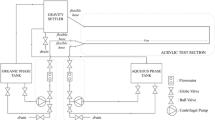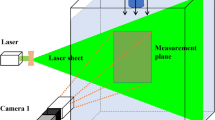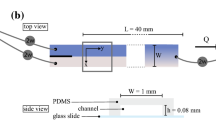Abstract
A tracking method and statistical analysis is introduced to quantify the mixing of moving droplets in the Lagrangian reference frame. Aqueous microrheology samples are produced as droplets in immiscible oil using a microfluidic T-junction. Samples from initially unmixed streams of the same viscosity-fluids (water/water) or different viscosity-fluids (water/glycerin solution) are dyed with different colors to visualize their internal motions and to quantify the extent of their mixing as a function of the age in the channel. The homogeneity of the material distribution in the drop is quantified by computing skewness of pixel intensity profiles or Shannon entropy index. Such analysis is important to ensure that samples are uniformly mixed for high-throughput rheological measurements using microrheology. Samples with a high viscosity ratio mix more rapidly than those with the same viscosities and the mixing length in traversing drops in the microchannel decays exponentially with traveling displacement until the drop reaches a diffusion limit.










Similar content being viewed by others
References
Abate A R, Lee D, Do T, Holtze C, Weitz D A (2008) Glass coating for PDMS microfluidic channels by sol-gel methods. Lab Chip 8:516–518
Breedveld V, Pine D J (2003) Microrheology as a tool for high-throughput screening. J Mat Sci 38:4461–4470
Burghelea T, Segre E, Bar-Joseph I, Groisman A, Steinberg V (2004) Chaotic flow and efficient mixing in a microchannel with a polymer solution. Phys Rev E 69:066305
Cabral J T, Hudson S D, Harrison C, Douglas J F (2004) Frontal photopolymerization for microfluidic applications. Langmuir 20:10020–10029
Chertkov M, Lebedev V (2003) Decay of scalar turbulence revisited. Phys Rev Lett 90:034501
Crocker J C, Grier D G (1996) Methods of digital video microscopy for colloidal studies. J Colloid Interface Sci 179:298–310
Crocker JC, Weeks E (2008). Particle tracking using UDL. Available at: http://www.physics.emory.edu/~weeks/idl/. Accessed 24 June 2013
Ducree J, Haeberle S, Brenner T, Glatzel T, Zengerle R (2006) Patterning of flow and mixing in rotating radial microchannels. Microfluid Nanofluid 2:97–105
Garstecki P, Fuerstman M J, Stone H A, Whitesides G M (2006) Formation of droplets and bubbles in a microfluidic T-junction-scaling and mechanism of break-up. Lab Chip 6:437–446
Handique K, Burns M A (2001) Mathematical modeling of drop mixing in a slit-type microchannel. J Micromech Microeng 11:548–554
Harrison C, Cabral J T, Stafford C M, Karim A, Amis E J (2004) A rapid prototyping technique for the fabrication of solvent-resistant structures. J Micromech Microeng 14:153–158
Hohne D N, Younger J G, Solomon M J (2009) Flexible microfluidic device for mechanical property characterization of soft viscoelastic solids such as bacterial biofilms. Langmuir 25:7743–7751
Kaufman M, Camesasca M, Manas-Zloczower I, Dudik L A, Liu C (2008) Applications of statistical physics to mixing in microchannels: entropy and multifractals. In: Vaseashta A, Mihailescu IN (eds) Nanoscale materials, devices, and systems for chem.-bio sensors, photonics, and energy generation and storage. Springer, Netherlands, pp 437–444
Kim H J, Beskok A (2007) Quantification of chaotic strength and mixing in a microfluidic system. J Micromech Microeng 17:2197–2210
Lebedev V, Turitsyn K S (2004) Passive scalar evolution in peripheral regions. Phys Rev E 69:036301
Mason T G, Ganesan K, van Zanten J H, Wirtz D, Kuo S C (1997) Particle tracking microrheology of complex fluids. Phys Rev Lett 79:3282–3285
Meunier P, Villermaux E (2003) How vortices mix. J Fluid Mech 476:213–222
Ng J M K, Gitlin I, Stroock A D, Whitesides G M (2002) Components for integrated poly(dimethylsiloxane) microfluidic systems. Electrophoresis 23:3461–3473
Phelps J H, Tucker III CL (2006) Lagrangian particle calculations of distributive mixing: limitations and applications. Chem Eng Sci 61(20):6826–6836
Sato J, Breedveld V (2006) Transient rheology of solvent-responsive complex fluids by integrating microrheology and microfluidics. J Rheol 50:1–19
Schultz K M, Furst E M (2011) High-throughput rheology in a microfluidic device. Lab Chip 11:3802–3809
Schultz K M, Baldwin A D, Kiick K L, Furst E M (2009a) Gelation of covalently cross-linked PEG-heparin hydrogels. Macromolecules 42:5310–5316
Schultz K M, Baldwin A D, Kiick K L, Furst E M (2009b) Rapid rheological screening to identify conditions of biomaterial hydrogelation. Soft Matter 5:740–742
Schultz K M, Bayles A V, Baldwin A D, Kiick K L, Furst E M (2011) Rapid, high resolution screening of biomaterial hydrogelators by μ 2-rheology. Biomacromolecules 12:4178–4182
Simonnet C, Groisman A (2005) Chaotic mixing in a steady flow in a microchannel. Phys Rev Lett 94:134501
Song H, Bringer M R, Tice J D, Gerdts C J, Ismagilov R F (2003) Experimental test of scaling of mixing by chaotic advection in droplets moving through microfluidic channels. Appl Phys Lett 83:4664–4666
Squires T M, Quake S R (2005) Microfluidics: fluid physics at the nanoliter scale. Rev Mod Phys 77:977–1026
Stoeber B, Liepmann D, Muller S J (2007) Strategy for active mixing in microdevices. Phys Rev E 75:0066314
Stone H A, Stroock A D, Ajdari A (2004) Engineering flows in small devices: microfluidics toward a lab-on-a-chip. Annu Rev Fluid Mech 36:381–411
Sivasamy J, Che Z, Neng Wong T, Nguyen N T, Yobas L (2010) A simple method for evaluating and predicting chaotic advection in microfluidic slugs. Chem Eng Sci 65(19):5382–5391
Thorsen T, Roberts R W, Arnold F H, Quake S R (2001) Dynamic pattern formation in a vesicle-generating microfluidic device. Phys Rev Lett 86:4163–4166
Tice J D, Lyon A D, Ismagilov R J (2004) Effects of viscosity on droplet formation and mixing in microfluidic channels. Anal Chim Acta 507:73–77
Tice J D, Song H, Lyon A D, Ismagilov R F (2003) Formation of droplets and mixing in multiphase microfluidics at low values of the Reynolds and the capillary numbers. Langmuir 19:9127–9133
Whitesides G M, Stroock A D (2001) Flexible methods for microfluidics. Phys Today 54:42–48
Xiao H, Liang D, Liu G, Guo M, Xing W, Cheng J (2006) Initial study of two-phase laminar flow extraction chip for sample preparation for gas chromatography. Lab Chip 6:1067–1072
Acknowledgments
This work was partially supported by Mid-career Researcher Program through NRF grant funded by the MEST (Ministry of Education, Science and Technology), Korea (No. 2010-0015186). This work was funded in part by a seed grant from the University of Delaware’s NIH Center of Biomedical Research Excellence, Molecular Design of Advanced Biomaterials (P20-RR017716).
Author information
Authors and Affiliations
Corresponding authors
Electronic supplementary material
Below is the link to the electronic supplementary material.
Rights and permissions
About this article
Cite this article
Han, H., Furst, E.M. & Kim, C. Lagrangian analysis of consecutive images: Quantification of mixing processes in drops moving in a microchannel. Rheol Acta 53, 489–499 (2014). https://doi.org/10.1007/s00397-014-0769-z
Received:
Revised:
Accepted:
Published:
Issue Date:
DOI: https://doi.org/10.1007/s00397-014-0769-z




